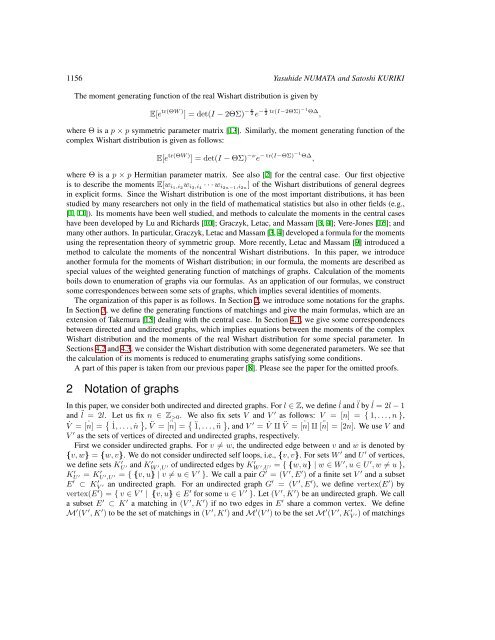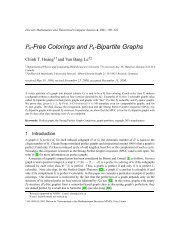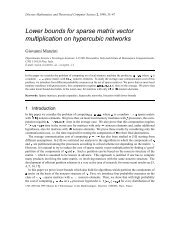On formulas for moments of the Wishart distributions as weighted ...
On formulas for moments of the Wishart distributions as weighted ...
On formulas for moments of the Wishart distributions as weighted ...
You also want an ePaper? Increase the reach of your titles
YUMPU automatically turns print PDFs into web optimized ePapers that Google loves.
1156 Y<strong>as</strong>uhide NUMATA and Satoshi KURIKI<br />
The moment generating function <strong>of</strong> <strong>the</strong> real <strong>Wishart</strong> distribution is given by<br />
E[e tr(ΘW ) ] = det(I − 2ΘΣ) − ν 2 e<br />
− 1 2 tr(I−2ΘΣ)−1 Θ∆ ,<br />
where Θ is a p × p symmetric parameter matrix [13]. Similarly, <strong>the</strong> moment generating function <strong>of</strong> <strong>the</strong><br />
complex <strong>Wishart</strong> distribution is given <strong>as</strong> follows:<br />
E[e tr(ΘW ) ] = det(I − ΘΣ) −ν e − tr(I−ΘΣ)−1 Θ∆ ,<br />
where Θ is a p × p Hermitian parameter matrix. See also [2] <strong>for</strong> <strong>the</strong> central c<strong>as</strong>e. Our first objective<br />
is to describe <strong>the</strong> <strong>moments</strong> E[w i1,i 2<br />
w i3,i 4<br />
· · · w i2n−1,i 2n<br />
] <strong>of</strong> <strong>the</strong> <strong>Wishart</strong> <strong>distributions</strong> <strong>of</strong> general degrees<br />
in explicit <strong>for</strong>ms. Since <strong>the</strong> <strong>Wishart</strong> distribution is one <strong>of</strong> <strong>the</strong> most important <strong>distributions</strong>, it h<strong>as</strong> been<br />
studied by many researchers not only in <strong>the</strong> field <strong>of</strong> ma<strong>the</strong>matical statistics but also in o<strong>the</strong>r fields (e.g.,<br />
[1, 11]). Its <strong>moments</strong> have been well studied, and methods to calculate <strong>the</strong> <strong>moments</strong> in <strong>the</strong> central c<strong>as</strong>es<br />
have been developed by Lu and Richards [10]; Graczyk, Letac, and M<strong>as</strong>sam [3, 4]; Vere-Jones [16]; and<br />
many o<strong>the</strong>r authors. In particular, Graczyk, Letac and M<strong>as</strong>sam [3, 4] developed a <strong>for</strong>mula <strong>for</strong> <strong>the</strong> <strong>moments</strong><br />
using <strong>the</strong> representation <strong>the</strong>ory <strong>of</strong> symmetric group. More recently, Letac and M<strong>as</strong>sam [9] introduced a<br />
method to calculate <strong>the</strong> <strong>moments</strong> <strong>of</strong> <strong>the</strong> noncentral <strong>Wishart</strong> <strong>distributions</strong>. In this paper, we introduce<br />
ano<strong>the</strong>r <strong>for</strong>mula <strong>for</strong> <strong>the</strong> <strong>moments</strong> <strong>of</strong> <strong>Wishart</strong> distribution; in our <strong>for</strong>mula, <strong>the</strong> <strong>moments</strong> are described <strong>as</strong><br />
special values <strong>of</strong> <strong>the</strong> <strong>weighted</strong> generating function <strong>of</strong> matchings <strong>of</strong> graphs. Calculation <strong>of</strong> <strong>the</strong> <strong>moments</strong><br />
boils down to enumeration <strong>of</strong> graphs via our <strong><strong>for</strong>mul<strong>as</strong></strong>. As an application <strong>of</strong> our <strong><strong>for</strong>mul<strong>as</strong></strong>, we construct<br />
some correspondences between some sets <strong>of</strong> graphs, which implies several identities <strong>of</strong> <strong>moments</strong>.<br />
The organization <strong>of</strong> this paper is <strong>as</strong> follows. In Section 2, we introduce some notations <strong>for</strong> <strong>the</strong> graphs.<br />
In Section 3, we define <strong>the</strong> generating functions <strong>of</strong> matchings and give <strong>the</strong> main <strong><strong>for</strong>mul<strong>as</strong></strong>, which are an<br />
extension <strong>of</strong> Takemura [15] dealing with <strong>the</strong> central c<strong>as</strong>e. In Section 4.1, we give some correspondences<br />
between directed and undirected graphs, which implies equations between <strong>the</strong> <strong>moments</strong> <strong>of</strong> <strong>the</strong> complex<br />
<strong>Wishart</strong> distribution and <strong>the</strong> <strong>moments</strong> <strong>of</strong> <strong>the</strong> real <strong>Wishart</strong> distribution <strong>for</strong> some special parameter. In<br />
Sections 4.2 and 4.3, we consider <strong>the</strong> <strong>Wishart</strong> distribution with some degenerated parameters. We see that<br />
<strong>the</strong> calculation <strong>of</strong> its <strong>moments</strong> is reduced to enumerating graphs satisfying some conditions.<br />
A part <strong>of</strong> this paper is taken from our previous paper [8]. Ple<strong>as</strong>e see <strong>the</strong> paper <strong>for</strong> <strong>the</strong> omitted pro<strong>of</strong>s.<br />
2 Notation <strong>of</strong> graphs<br />
In this paper, we consider both undirected and directed graphs. For l ∈ Z, we define ˙l and ¨l by ˙l = 2l − 1<br />
and ¨l = 2l. Let us fix n ∈ Z >0 . We also fix sets V and V ′ <strong>as</strong> follows: V = [n] = { 1, . . . , n },<br />
˙V = [n] ˙ = { ˙1, . . . , ṅ } , ¨V = [n] ¨ = { ¨1, . . . , ¨n } , and V ′ = ˙V ∐ ¨V = [n] ˙ ∐ [n] ¨ = [2n]. We use V and<br />
V ′ <strong>as</strong> <strong>the</strong> sets <strong>of</strong> vertices <strong>of</strong> directed and undirected graphs, respectively.<br />
First we consider undirected graphs. For v ≠ w, <strong>the</strong> undirected edge between v and w is denoted by<br />
{v, w} = {w, v}. We do not consider undirected self loops, i.e., {v, v}. For sets W ′ and U ′ <strong>of</strong> vertices,<br />
we define sets K U ′ and ′ K′ W ′ ,U <strong>of</strong> undirected edges by ′ K′ W ′ ,U = { {w, u} | w ∈ W ′ , u ∈ U ′ , w ≠ u },<br />
′<br />
K U ′ = ′ K′ U ′ ,U = { {v, u} | v ≠ u ∈ V ′ }. We call a pair G ′ = (V ′ , E ′ ) <strong>of</strong> a finite set V ′ and a subset<br />
′<br />
E ′ ⊂ K V ′ an undirected graph. For an undirected graph ′ G′ = (V ′ , E ′ ), we define vertex(E ′ ) by<br />
vertex(E ′ ) = { v ∈ V ′ | {v, u} ∈ E ′ <strong>for</strong> some u ∈ V ′ }. Let (V ′ , K ′ ) be an undirected graph. We call<br />
a subset E ′ ⊂ K ′ a matching in (V ′ , K ′ ) if no two edges in E ′ share a common vertex. We define<br />
M ′ (V ′ , K ′ ) to be <strong>the</strong> set <strong>of</strong> matchings in (V ′ , K ′ ) and M ′ (V ′ ) to be <strong>the</strong> set M ′ (V ′ , K V ′ ′) <strong>of</strong> matchings






